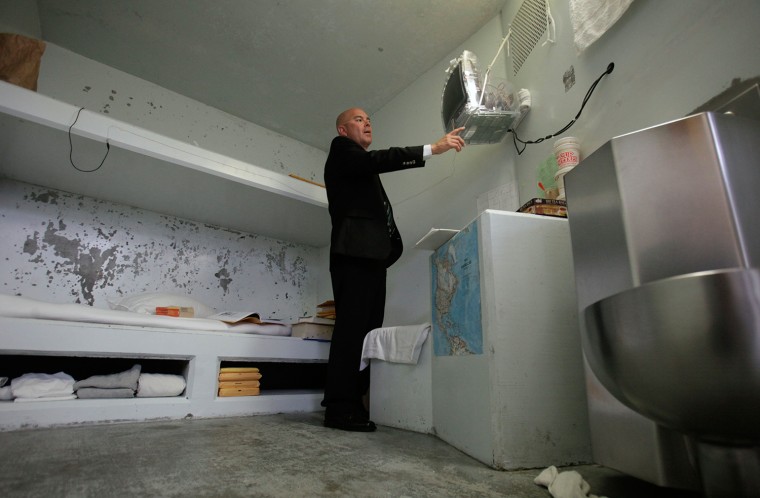For some California inmates believed to be involved with prison gangs, home is a 7½-by-12-foot box — with no windows, no roommates and no idea how many years they’ll be in isolation.
On July 8, almost 30,000 prisoners across the state started refusing meals to protest what they say is inhumane treatment for those sent to solitary confinement for indefinite stays. About 2,300 still have yet to eat, 11 days later.
The hunger strike, the third in two years, is the latest problem for the troubled California prison system, which is under court order to release 10,000 inmates this year to ease overcrowding.
The prisoners are demanding an end to indefinite stays in so-called Security Housing Units — forbidding cells where some inmates are isolated for as much as 23 hours a day.
“They’ve committed a crime, and they are willing to accept punishment,” said Jules Lobel, a lawyer challenging the California system in federal court. “But this is so far out of the ordinary that they consider it a form of torture, and I think that’s correct.”
While the cells have been described by former inmates as living tombs, state prison officials point out that each has cable TV — 27 channels — and that prisoners are allowed visitors, even chessboards.
Prisoners get finite terms in the isolation units for breaking prison rules. But if they are deemed to be a member of a prison gang or associated with one, they can be put in confinement indefinitely.
Advocates for the prisoners say the accusations of gang affiliation are based on an extremely broad definition, that challenging them is almost impossible, and that the only way out is to snitch on other gang members.
“If you’re exercising with someone who’s in a gang, that’s enough,” said Carol Strickman, a lawyer at Legal Services for Prisoners with Children who has worked with the strikers. “And you say, wait a minute, I was doing pushups — it doesn’t matter.”
Terry Thornton, a spokeswoman for the California Department of Corrections and Rehabilitation, pointed to reforms put in place last year that raised the bar for some inmates to be sent to the isolation units.
In addition, new provisions allow inmates to demonstrate their commitment to refraining from gang activity in ways other than snitching on other inmates, she said.
“They can earn their way out without even dropping out of their gang,” she said.
State prison officials say that participation in the hunger strike has dropped to about 2,300 inmates from 12,000 on July 11 when state started keeping count. The state considers prisoners on hunger strike after they have missed nine meals in a row.
California protocol allows for force-feeding under only two circumstances — when the prisoner has refused to clearly indicate his wishes about resuscitation and when the prison proves to a court that the prisoner can’t give informed consent.
Forty-five men on a months-long hunger strike at the U.S. prison at Guantanamo Bay, Cuba, are being force-fed. They are protesting indefinite detention and conditions at the facility.
A federal judge this week denied a request by three of them that she order an end to the force feeding. She said the prisoners’ true complaint was that “the United States is not allowing them to commit suicide by starvation.”
In California, lawyers who have visited the striking inmates say that they see no sign of fading determination.
“I think they’re weakening,” said Lobel, who is also president of the Center for Constitutional Rights and a University of Pittsburgh law professor. “They’ve lost a considerable amount of weight. But they are emotionally strong in the sense that they are determined to get some justice. They’re not about to give up.”
The California system’s problems are well-documented. Two years ago, the Supreme Court ruled that the state’s prisons were so crowded they violated the constitutional protection against cruel and unusual punishment.
California passed a law the following year that led to a reduction in the prison population by 25,000, to about 120,000. Gov. Jerry Brown declared earlier this year that the crisis was over, and has vowed to fight courts pushing him to do more.
The woes aren’t limited to overcrowding. State lawmakers want an investigation into a report by the Center for Investigative Reporting that doctors pressured as many as 148 women into being sterilized in California prisons over the last decade.
And in June, a federal judge ruled the state had to move about 3,000 inmates from two California prisons because they were not getting proper care and were in danger of contracting a dangerous airborne fungus.
Besides an end to indefinite isolation, the inmates on hunger strike want expanded privileges and improved food, according to their advocates outside the prison gates. The state has shown no sign that it will negotiate.
Dolores Canales, the mother of an inmate who has spent more than 12 years in solitary, told the syndicated radio program “Democracy Now” on Wednesday that she feels buried alive just imagining it.
She said the last time her son saw natural light was more than two years ago, and that was on a bus during a transfer from one prison to another.
“I wake up in the night and I can’t breathe and I have anxiety,” she said, “because I just imagine what it’s like to be entombed day in and day out in a cement cell like that.”
— Reuters and The Associated Press contributed to this report.
